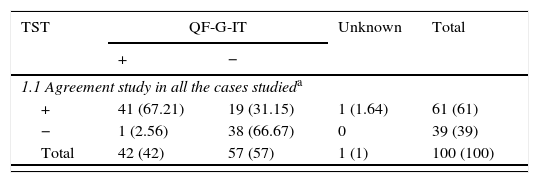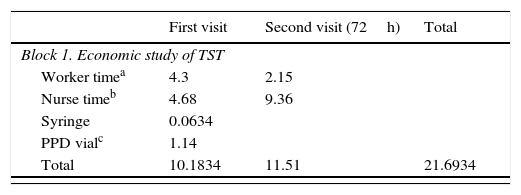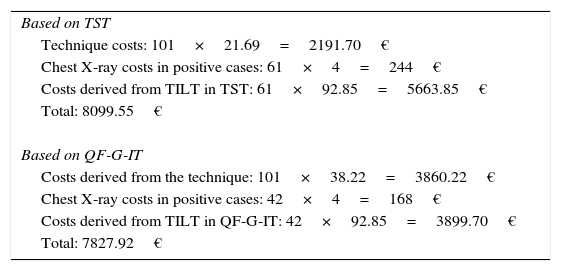Recently diagnosis of latent tuberculosis infection (LTBI) can be made using the tuberculin skin test (TST) or by techniques known as interferon-γ release assays (IGRAS), being QuantiFERON®-TB Gold In-Tube (QF-G-IT) the most used. The IGRAS avoid some drawbacks of the TST, especially cross-reaction with bacillus Calmette-Guérin (BCG) vaccine, but also present some problems such as those arising from cost and the need of having an adequate infrastructure and experience. There is no clear consensus on which technique should be preferentially used for the diagnosis of LTBI.
MethodsThis is a comparative study between the TST and QT-G-IT in a cohort of contacts of patients with pulmonary tuberculosis during the study period. An analysis of global agreement and groups was performed according to whether the contacts were vaccinated with BCG or not. A study of costs of both techniques and diagnostic strategies based on these techniques was performed.
ResultsThe agreement between TST and QF-G-IT was acceptable in the whole sample yet it was very good in the unvaccinated group. Few cases of indeterminate values were recorded. The cost study showed that TST was cheaper than QF-G-IT; however when we analysed the cost of the strategies according to each technique, the QF-G-IT showed a better cost-benefit.
ConclusionWe suggest considering QF-G-IT as the only preferred technique for the diagnosis of LTBI in household contacts, based on good overall agreement between the 2 techniques (even if we eliminate the effect of the vaccine) and a cost analysis favourable to QF-G-IT.
El diagnóstico de la infección latente tuberculosa (ILT) es posible realizarlo mediante la prueba de la tuberculina (PT) o bien a través de las denominadas técnicas de interferon-γ release assays (IGRAS, «análisis de liberación del interferón-γ»), siendo QuantiFERON®-TB Gold In-Tube (QF-G-IT) la más usada. Los IGRAS permiten evitar algunos inconvenientes de la PT, especialmente la reacción cruzada con la vacuna con bacilo de Calmette-Guérin (BCG). No obstante, también presentan algunos problemas, como son los derivados del coste de la técnica, así como el ser un método de laboratorio que precisa una infraestructura y experiencia adecuadas. No existe un claro consenso sobre cuál de las técnicas debería utilizarse de forma prioritaria para el diagnóstico de la ILT.
MétodoSe trata de un estudio comparativo entre la PT y la QF-G-IT en nuestra cohorte de contactos de pacientes con tuberculosis pulmonar durante el período de estudio (n=101). Se realizó un análisis de la concordancia global y por grupos según los contactos estuvieran vacunados con BCG o no. Se realizó, además, un estudio de costes de ambas técnicas y de las estrategias diagnósticas basadas en ellas.
ResultadosLa concordancia entre la PT y la QF-G-IT fue aceptable en el global de la muestra, pero muy buena en el grupo de no vacunados. Se registraron muy pocos casos de valores indeterminados. El estudio de costes mostró que la PT era más económica que la QF-G-IT; sin embargo, al analizar el coste de las estrategias según cada técnica, la PT mostró un mayor coste-beneficio.
ConclusiónAconsejamos considerar QF-G-IT como la única y preferente técnica para el diagnóstico de la ILT en contactos convivientes, basados en una buena concordancia general entre ambas técnicas (más aún si eliminamos el efecto de la vacuna) y un estudio de costes favorable a QF-G-IT.









